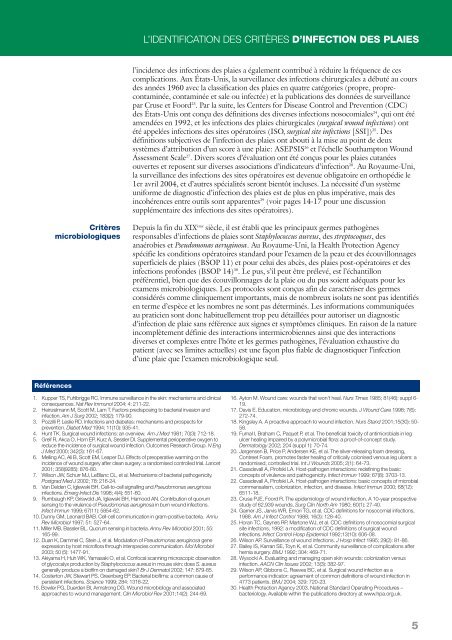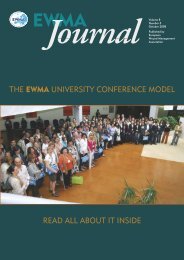L'identification des critères d'infection des plaies - EWMA
L'identification des critères d'infection des plaies - EWMA
L'identification des critères d'infection des plaies - EWMA
Create successful ePaper yourself
Turn your PDF publications into a flip-book with our unique Google optimized e-Paper software.
Références<br />
Critères<br />
microbiologiques<br />
1. Kupper TS, Fuhlbrigge RC. Immune surveillance in the skin: mechanisms and clinical<br />
consequences. Nat Rev Immunol 2004; 4: 211-22.<br />
2. Heinzelmann M, Scott M, Lam T. Factors predisposing to bacterial invasion and<br />
infection. Am J Surg 2002; 183(2): 179-90.<br />
3. Pozzilli P, Leslie RD. Infections and diabetes: mechanisms and prospects for<br />
prevention. Diabet Med 1994; 11(10): 935-41.<br />
4. Hunt TK. Surgical wound infections: an overview. Am J Med 1981; 70(3): 712-18.<br />
5. Greif R, Akca O, Horn EP, Kurz A, Sessler DI. Supplemental perioperative oxygen to<br />
reduce the incidence of surgical wound infection. Outcomes Research Group. N Eng<br />
J Med 2000; 342(3): 161-67.<br />
6. Melling AC, Ali B, Scott EM, Leaper DJ. Effects of preoperative warming on the<br />
incidence of wound surgery after clean surgery: a randomised controlled trial. Lancet<br />
2001; 358(9285): 876-80.<br />
7. Wilson JW, Schurr MJ, LeBlanc CL, et al. Mechanisms of bacterial pathogenicity.<br />
Postgrad Med J 2002; 78: 216-24.<br />
8. Van Delden C, Iglewski BH. Cell-to-cell signalling and Pseudomonas aeruginosa<br />
infections. Emerg Infect Dis 1998; 4(4): 551-60.<br />
9. Rumbaugh KP, Griswold JA, Iglewski BH, Hamood AN. Contribution of quorum<br />
sensing to the virulence of Pseudomonas aeruginosa in burn wound infections.<br />
Infect Immun 1999; 67(11): 5854-62.<br />
10. Dunny GM, Leonard BAB. Cell-cell communication in gram-positive bacteria. Annu<br />
Rev Microbiol 1997; 51: 527-64.<br />
11. Miller MB, Bassler BL. Quorum sensing in bacteria. Annu Rev Microbiol 2001; 55:<br />
165-99.<br />
12. Duan K, Dammel C, Stein J, et al. Modulation of Pseudomonas aeruginosa gene<br />
expression by host microflora through interspecies communication. Mol Microbiol<br />
2003; 50 (5): 1477-91.<br />
13. Akiyama H, Huh WK, Yamasaki O, et al. Confocal scanning microscopic observation<br />
of glycocalyx production by Staphylococcus aureus in mouse skin: does S. aureus<br />
generally produce a biofilm on damaged skin? Br J Dermatol 2002; 147: 879-85.<br />
14. Costerton JW, Stewart PS, Greenberg EP. Bacterial biofilms: a common cause of<br />
persistent infections. Science 1999; 284: 1318-22.<br />
15. Bowler PG, Duerden BI, Armstrong DG. Wound microbiology and associated<br />
approaches to wound management. Clin Microbiol Rev 2001;14(2): 244-69.<br />
L’IDENTIFICATION DES CRITÈRES D’INFECTION DES PLAIES<br />
l’incidence <strong>des</strong> infections <strong>des</strong> <strong>plaies</strong> a également contribué à réduire la fréquence de ces<br />
complications. Aux États-Unis, la surveillance <strong>des</strong> infections chirurgicales a débuté au cours<br />
<strong>des</strong> années 1960 avec la classification <strong>des</strong> <strong>plaies</strong> en quatre catégories (propre, proprecontaminée,<br />
contaminée et sale ou infectée) et la publications <strong>des</strong> données de surveillance<br />
par Cruse et Foord 23 . Par la suite, les Centers for Disease Control and Prevention (CDC)<br />
<strong>des</strong> États-Unis ont conçu <strong>des</strong> définitions <strong>des</strong> diverses infections nosocomiales 24 , qui ont été<br />
amendées en 1992, et les infections <strong>des</strong> <strong>plaies</strong> chirurgicales (surgical wound infections) ont<br />
été appelées infections <strong>des</strong> sites opératoires (ISO, surgical site infections [SSI]) 25 . Des<br />
définitions subjectives de l’infection <strong>des</strong> <strong>plaies</strong> ont abouti à la mise au point de deux<br />
systèmes d’attribution d’un score à une plaie: ASEPSIS 26 et l’échelle Southampton Wound<br />
Assessment Scale 27 . Divers scores d’évaluation ont été conçus pour les <strong>plaies</strong> cutanées<br />
ouvertes et reposent sur diverses associations d’indicateurs d’infection 28 . Au Royaume-Uni,<br />
la surveillance <strong>des</strong> infections <strong>des</strong> sites opératoires est devenue obligatoire en orthopédie le<br />
1er avril 2004, et d’autres spécialités seront bientôt incluses. La nécessité d’un système<br />
uniforme de diagnostic d’infection <strong>des</strong> <strong>plaies</strong> est de plus en plus impérative, mais <strong>des</strong><br />
incohérences entre outils sont apparentes 29 (voir pages 14-17 pour une discussion<br />
supplémentaire <strong>des</strong> infections <strong>des</strong> sites opératoires).<br />
Depuis la fin du XIX ème siècle, il est établi que les principaux germes pathogènes<br />
responsables d’infections de <strong>plaies</strong> sont Staphylococcus aureus, <strong>des</strong> streptocoques, <strong>des</strong><br />
anaérobies et Pseudomonas aeruginosa. Au Royaume-Uni, la Health Protection Agency<br />
spécifie les conditions opératoires standard pour l’examen de la peau et <strong>des</strong> écouvillonnages<br />
superficiels de <strong>plaies</strong> (BSOP 11) et pour celui <strong>des</strong> abcès, <strong>des</strong> <strong>plaies</strong> post-opératoires et <strong>des</strong><br />
infections profon<strong>des</strong> (BSOP 14) 30 . Le pus, s’il peut être prélevé, est l’échantillon<br />
préférentiel, bien que <strong>des</strong> écouvillonnages de la plaie ou du pus soient adéquats pour les<br />
examens microbiologiques. Les protocoles sont conçus afin de caractériser <strong>des</strong> germes<br />
considérés comme cliniquement importants, mais de nombreux isolats ne sont pas identifiés<br />
en terme d’espèce et les nombres ne sont pas déterminés. Les informations communiquées<br />
au praticien sont donc habituellement trop peu détaillées pour autoriser un diagnostic<br />
d’infection de plaie sans référence aux signes et symptômes cliniques. En raison de la nature<br />
incomplètement définie <strong>des</strong> interactions intermicrobiennes ainsi que <strong>des</strong> interactions<br />
diverses et complexes entre l’hôte et les germes pathogènes, l’évaluation exhaustive du<br />
patient (avec ses limites actuelles) est une façon plus fiable de diagnostiquer l’infection<br />
d’une plaie que l’examen microbiologique seul.<br />
16. Ayton M. Wound care: wounds that won’t heal. Nurs Times 1985; 81(46): suppl 6-<br />
19.<br />
17. Davis E. Education, microbiology and chronic wounds. J Wound Care 1998; 7(6):<br />
272-74.<br />
18. Kingsley A. A proactive approach to wound infection. Nurs Stand 2001;15(30): 50-<br />
58.<br />
19. Fumal I, Braham C, Paquet P, et al. The beneficial toxicity of antimicrobials in leg<br />
ulcer healing impaired by a polymicrobial flora: a proof-of-concept study.<br />
Dermatology 2002; 204 (suppl 1): 70-74.<br />
20. Jørgensen B, Price P, Andersen KE, et al. The silver-releasing foam dressing,<br />
Contreet Foam, promotes faster healing of critically colonised venous leg ulcers: a<br />
randomised, controlled trial. Int J Wounds 2005; 2(1): 64-73.<br />
21. Casadevall A, Pirofski LA. Host-pathogen interactions: redefining the basic<br />
concepts of virulence and pathogenicity. Infect Immun 1999; 67(8): 3703-13.<br />
22. Casadevall A, Pirofski LA. Host-pathogen interactions: basic concepts of microbial<br />
commensalism, colonization, infection, and disease. Infect Immun 2000; 68(12):<br />
6511-18.<br />
23. Cruse PJE, Foord R. The epidemiology of wound infection. A 10-year prospective<br />
study of 62,939 wounds. Surg Clin North Am 1980; 60(1): 27-40.<br />
24. Garner JS, Jarvis WR, Emori TG, et al. CDC definitions for nosocomial infections,<br />
1988. Am J Infect Control 1988; 16(3): 128-40.<br />
25. Horan TC, Gaynes RP, Martone WJ, et al. CDC definitions of nosocomial surgical<br />
site infections, 1992: a modification of CDC definitions of surgical wound<br />
infections. Infect Control Hosp Epidemiol 1992;13(10): 606-08.<br />
26. Wilson AP. Surveillance of wound infections. J Hosp Infect 1995; 29(2): 81-86.<br />
27. Bailey IS, Karran SE, Toyn K, et al. Community surveillance of complications after<br />
hernia surgery. BMJ 1992; 304: 469-71.<br />
28. Wysocki A. Evaluating and managing open skin wounds: colonization versus<br />
infection. AACN Clin Issues 2002; 13(3): 382-97.<br />
29. Wilson AP, Gibbons C, Reeves BC, et al. Surgical wound infection as a<br />
performance indicator: agreement of common definitions of wound infection in<br />
4773 patients. BMJ 2004; 329: 720-23.<br />
30. Health Protection Agency 2003. National Standard Operating Procedures –<br />
bacteriology. Available within the publications directory at www.hpa.org.uk.<br />
5
















